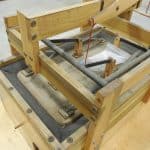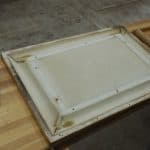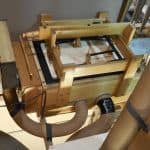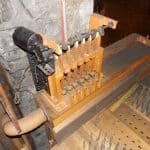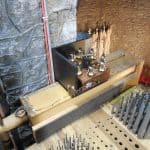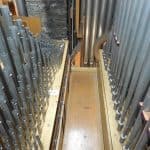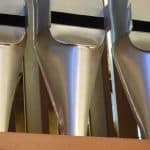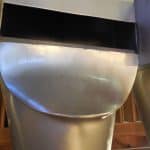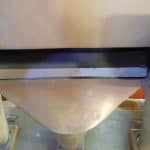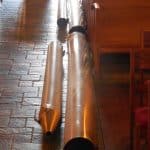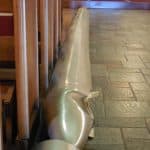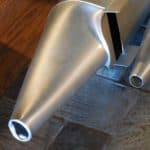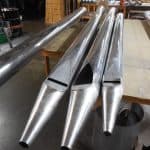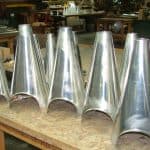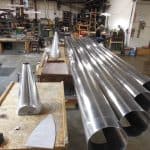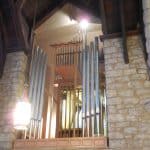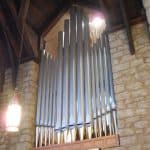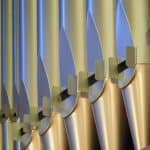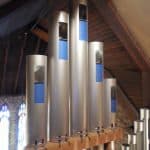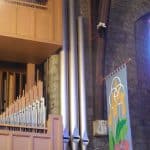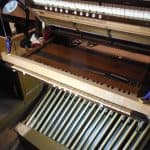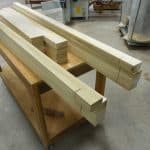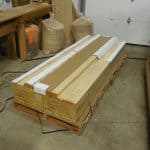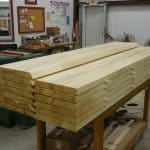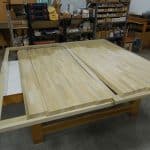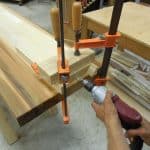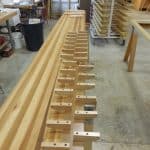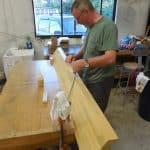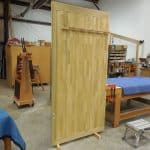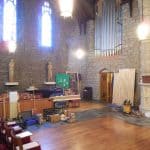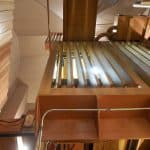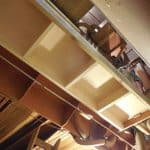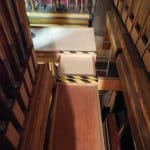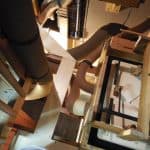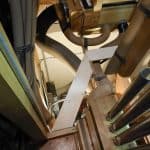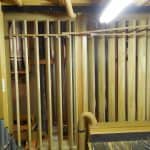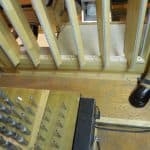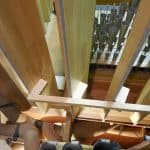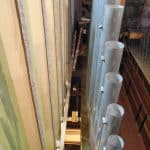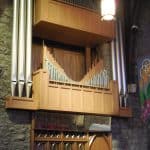Dr. Richard Konzen, Organist-Choirmaster at St. John’s Episcopal Church in Youngstown, Ohio, contacted me in the summer of 2014 about looking at the church’s organ, which had a number of mechanical issues — none of them catastrophic, but annoying nonetheless. Dick was familiar with our Opus 1 from visits to Greencastle, Indiana (he had once been a student of Art Carkeek), plus we had done some work on the organs at Grove City College, where he was then the Professor of Organ. My report to the church outlined a number of problems and our suggested solution for each. We took over regular maintenance of the instrument in the fall of 2014; meanwhile, the church’s capital campaign proceeded until we were able to sign a contract in September 2016. Work commenced in May 2017 with the removal of a water-damaged schwimmer reservoir and some measurement-taking. The wooden parts of the reservoir were renewed or replaced as appropriate, and new rubber cloth installed. The renewed reservoir was installed at the end of May.
At this same time, the bottom 13 notes of the Pedal Principal 16’ were removed and picked up by A.R. Schopp’s Sons, Inc. of Alliance, Ohio. These zinc pipes had been problematic for decades, and over half of those notes had stopped speaking a long time ago. C1-As11 were remade in heavy aluminum with soldered-in lips of organ metal, while B12 and c13 were provided to help match the finish. Oyster Pipe Works, Ltd. of Louisville, Ohio also removed the 12 notes of the Pedal Contra Fagott 32’ for extensive shallot reworking (these pipes were added around 2000 along with the Antiphonal, and my report said “…the individual notes, when played, reminded me of a diesel engine.”), along with the 44 notes of the Pedal Posaune/Trumpet unit, which needed much less work to simply “warm up” the sound a bit. Fred also took a few inside pipes for zinc repairs, as well as for matching the 32’.
All new/repaired pipes were brought back at the end of June 2017, installed, tonally finished and tuned. The keyboards were also renewed at this time with new felts and plastic nuts, including new cloth on the magnetic tracker-touch bar, after which all 3 manuals were regulated for consistent travel and speech points. A new Cymbalstern (replacing the noisy original unit, now stored in the base of the organ, which had been driven by a failing windshield-wiper motor) was installed as well. Other minor electrical issues with the console were also addressed on this trip, and everything was finished in time for Janette Fishell’s recital during the AGO Regional Convention at the beginning of July.
The last phase of work addressed the swell shutters, which —although well made — were of a design that didn’t close tightly. We built new shutters of laminated jelutong (for maximum stability) with beveled and felted edges, and mounted these in slightly overwidth frames of our normal design. The frames were planed on site for a snug fit in the existing openings, none of which turned out to be square! The shutters now close completely, and also open a bit more than the originals, so the dynamic range of the Swell is noticeably wider now. A new walkboard was installed between the Transept façade and shutters, which not only facilitated the shutter work but will also make future maintenance much safer. This final phase, completed in August 2017, also addressed a number of minor voicing issues, such as slightly sagging languids in some flue basses.
Schlicker Organ Co., Inc., Buffalo, New York — 1966
GREAT (Manual II, C1-c61)
Pommer 16’
Principal 8’
Spitz Floete 8’
Travers Floete 8′ (prepared-for)
Octave 4’
Hohl Floete 4′ (prepared-for)
Quint 22⁄3’
Octave 2’
Mixture VI (2’)
Trumpet 8’
Trompete Real 8’ (AN)
Swell to Great 16’
Swell to Great 8’
Swell to Great 4’
Positiv to Great 16’
Positiv to Great 8’
Antiphonal to Great 8’
MIDI on Great
SWELL (Manual III, C1-c61, enclosed)
Lieblich Gedeckt 16′ (prepared-for)
Rohr Floete 8’
Salicional 8’
Voix Celeste 8’ (from F6)
Principal 4’
Spiel Floete 4’
Nasat 22⁄3’
Nachthorn 2’
Terz 13⁄5’ (from c13)
Mixture V (11⁄3’)
Fagott 16’
Schalmei 8’
Clairon 4’
Tremolo
Swell to Swell 16’
Swell to Swell 4’
Trompete Real 8’ (AN)
MIDI on Swell
POSITIV (Manual I, C1-c61)
Gedeckt 8’
Rohr Floete 4’
Principal 2’
Block Floete 2’ (prepared-for)
Terz 13⁄5’ (f18-f54)
Klein Nasat 11⁄3’
Siffloete 1’
Scharf IV (1’)
Cymbal III (1⁄5’)
Krummhorn 8’
Tremolo
Swell to Positiv 8’
Swell to Positiv 4’
Antiphonal to Positiv 8’
Trompete Real 8’ (AN)
Cymbalstern
MIDI on Positiv
ANTIPHONAL (floating, C1-c61)
Gedeckt 8’ (actually a Principal)
Octave 4’
Gemshorn 2’
Mixture III (1’) (actually 4 ranks)
Trompete Real 8’
Great Positiv Transfer
PEDAL (C1-g32, AGO)
Resultant 32’
Untersatz 32’ (ext.)
Principal 16’
Subbass 16’
Pommer 16’ (GR)
Octave 8’ (ext.)
Spitz Floete 8’ (GR)
Gedeckt 8’ (prepared-for)
Choral Bass 4’
Pommer 4’ (GR)
Hohl Floete 2’ (prepared-for)
Mixture III (2’)
Contra Fagott 32’ (ext. SW)
Posaune 16’
Fagott 16’ (SW)
Trumpet 8’ (ext.)
Schalmei 4’
Cornet 2’ (ext.)
Great to Pedal 8’
Swell to Pedal 8’
Positiv to Pedal 8’
Antiphonal to Pedal 8’
Trompete Real 8’ (AN)
MIDI on Pedal
